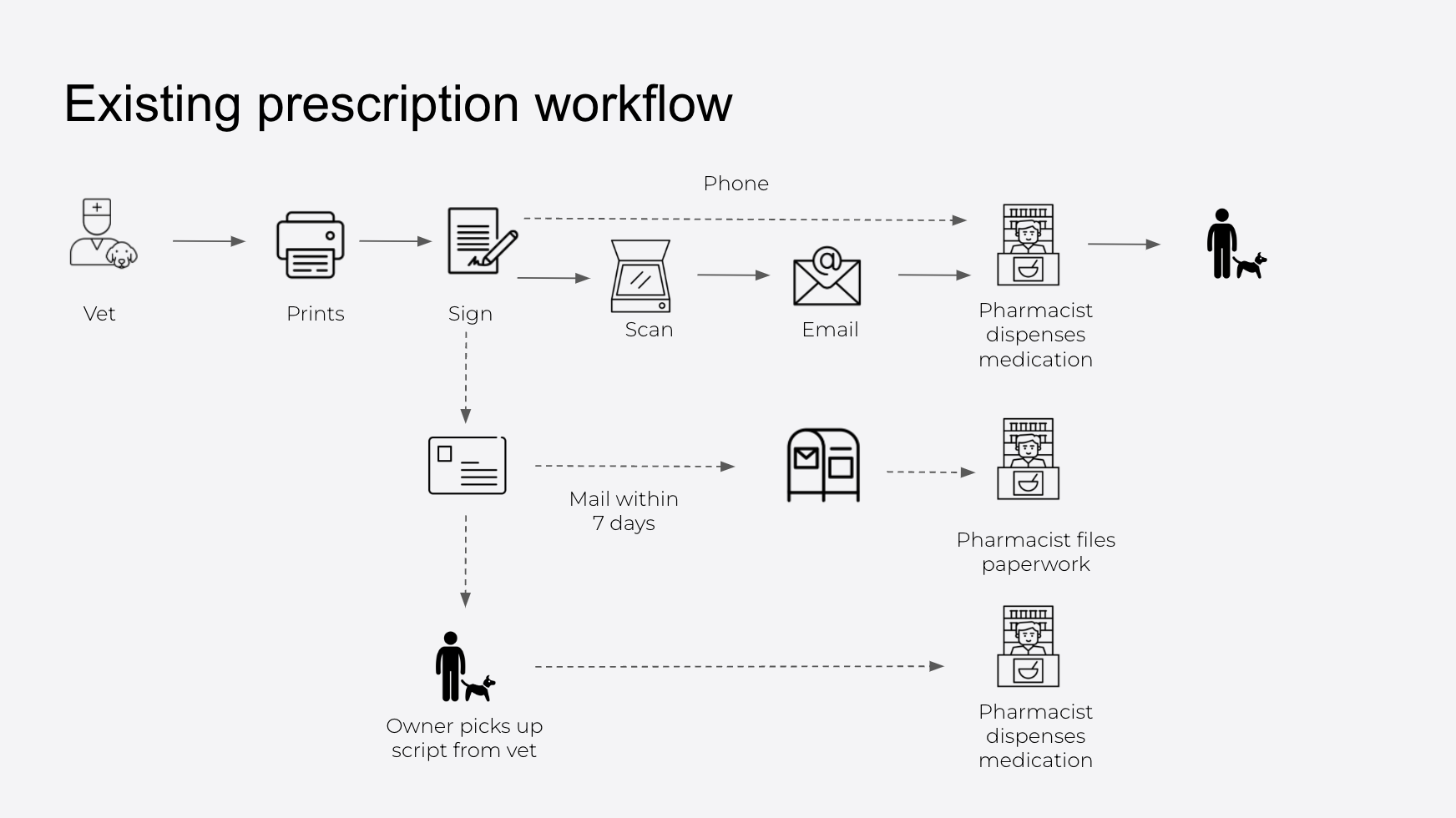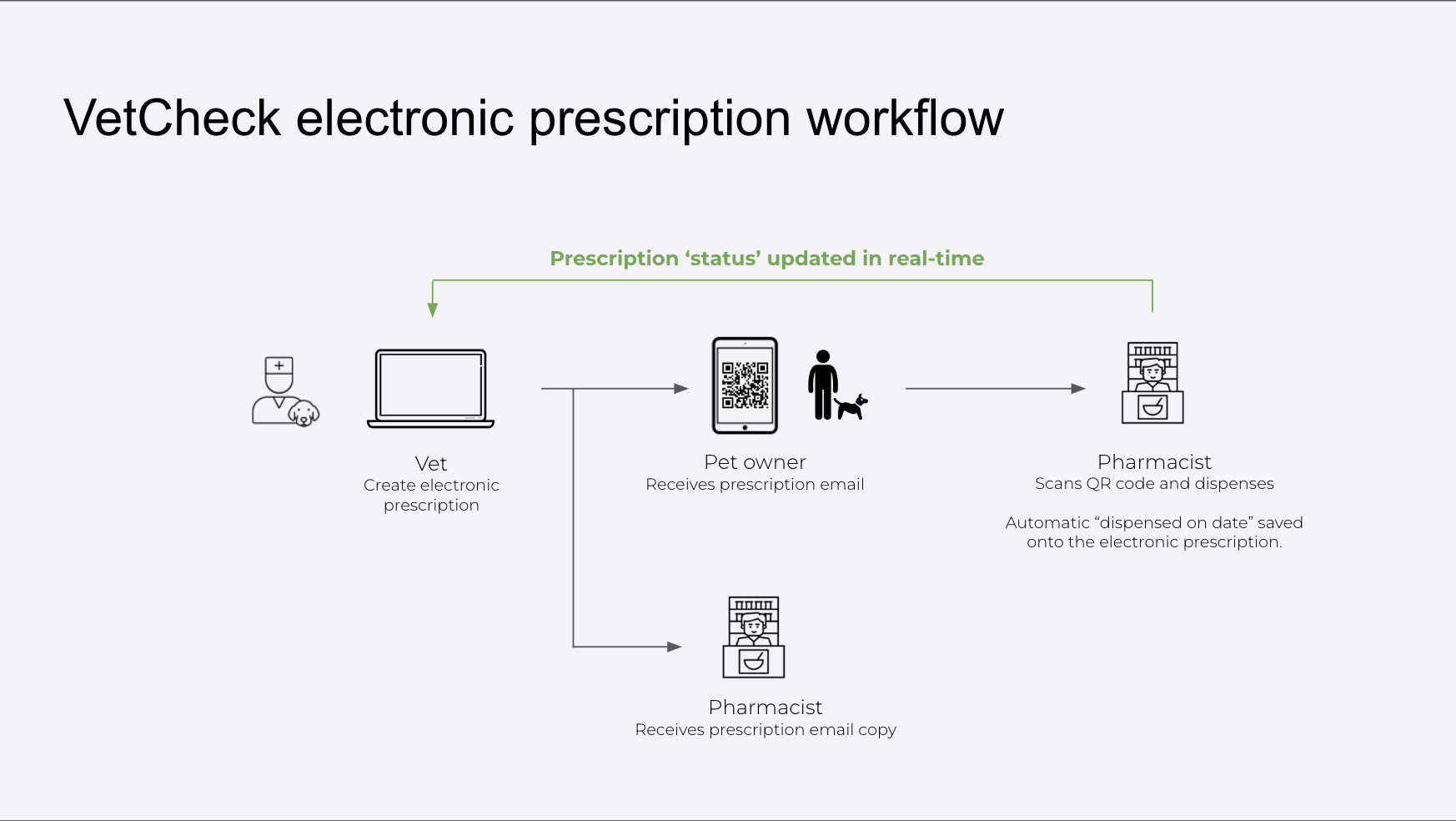
VETERINARY ELECTRONIC PRESCRIPTIONS
As technology has been advancing at such a rapid rate in the last few decades, many services have been made into digital versions. Medicine, being one of the most respected and impactful services, is one of them. Whether it be professional online healthcare consultations, escripts, or impressive fitness trackers that's in our handheld devices, these softwares make our lives so much easier. Here, we take a look at the use of electronic prescriptions in veterinary medicine.
What exactly is a traditional prescription? It means a registered veterinarian handing the client a signed paper prescription to take it to the pharmacy to collect the prescribed medicine. Here are the concerns surrounding the traditional method of prescribing drugs in veterinary medicine.

- It's slow and inefficient
- Telemedicine and remote veterinary consults are not supported
- Only one printed copy
- Urgent situations
- Lack of transparency
- Potential fraud
- No automatic expiry or cancellation
A vet has to create the prescritpion digitally, print, sign, scan and email to the pharmacy. Then mail the original copy to the pharmacy.
If a veterinarian is giving an online consultation remotely to a patient, they would still have to print, sign, scan, email and post to the pharmacy. Or post a copy to the client for them to retrieve at a local pharmacy.
When a patient is given the written prescription, they would have to retrieve medicine from a pharmacy. But they can only do that if they doesn't lose the paper first. If lost, they would have to go to the clinic again, wasting more time and making everything slower.
Sometimes a patient or an animal may be in need of urgent care or medicine. Every second they have to wait for this paper process is stressul to the client.
When clinics don't have the records of patients receiving the medicine, it can cause confusion in managing medication repeats and the pet's condition.
If a prescription is on paper and leaves no record, there is a chance for drug fraud.
There is no regulation around prescription expiration.
Benefits of Electronic Prescriptions in Veterinary Practice
Fortunately, many problems associated with traditional paper prescriptions can be resolved with electronic prescriptions. E-scripts or electronic prescriptions are exactly what it sounds like - a digital version of a paper prescription. Electronic prescribing means doctors and veterinarians use software to generate, transmit and track prescriptions sent to the pharmacy. A patient would receive an email or SMS message of the prescriber and then show it to the pharmacy to collect it. Here are some benefits of this process:

- Increases medical safety
- Increases healthcare efficiency
- Improves patient safety
- Easy Recall Easily review electronic prescriptions from within the practice management system and know if and when the medication was dispensed.
- Saves money and time for clinics
- Increased security
- Prescriptions MUST be printed from the veterinary prescribing software, which is separated from the compounding pharmacy software, so there is a unique record for each prescription in the software
- Prescriptions issued MUST be endorsed “FOR ANIMAL TREATMENT ONLY”
- A hardcopy of the prescription MUST be sent to the pharmacy
- The prescription MUST NOT be pre-signed
- The prescriber MUST sign the paper prescription with handwriting as near as possible below the last medication prescribed on the form
- The prescriber MUST rewrite the following fields if S8 medications are prescribed:
- The name of the substance or the preparation containing it, including the strength when more than one strength is available
- The quantity prescribed in both words and figures (numerals)
- Adequate directions for use
- The number of repeats authorised if the prescription is to be dispensed more than once and, if repeats are ordered, the time interval for repeats
- The clinical or prescription record of the patient MUST be preserved for AT LEAST 7 years from the date on which the prescription was produced and can be accessed when required.
- Initial prescription MUST be immediately destroyed when an alteration is made to form a new prescription.
Because it's digital and clinics are able to keep track of a patient's prescription and his medical history, prescribers would have more transparency in what has been prescribed and dispensed previously.
Without having to print, scan or mail traditional paper prescriptions for patients to carry around, it would mean that time is saved. It would also save time if the whole process was done online and the pharmacy delivers the medicine to the patient's home.
By monitoring a patient's prescription and medical backgrounds closely, a healthcare provider would be able to better prevent adverse events, inappropriate drug-drug interactions or even illegal retrieval of drugs, as well as ensure appropriate dosing.
Without the need of printing, scanning, or posting paper prescriptions, a lot of mechanical costs can be cut. Vet practices can also have staff focus on work other than generating a paper prescription, which can also lead to increased practice efficiency and associated cost savings.
With unique tokens, identifiers such as a QR code for each prescription, it is easier to track the progress of dispensing medicine and location of the medicine being dispensed. Therefore, the chances of patients or clients fraudulently obtaining medicine will be lessened by a lot.
Electronic prescriptions are a game-changer for everyone, but it's understandable that traditional prescriptions have been used for centuries, yet laws were implemented in many developed countries such as the U.S. that require electronic prescriptions instead of traditional ones in human medicine. We see it in human medicine, there's no reason not to roll it out globally for veterinary medicines.
Why some pharmacies still request ink signatures
Digital veterinary softwares are being used in veterinary clinics more and more. However, the legislation around digital signatures are still lagging in the veterinary space. It's true that currently there are pharmacies that accept them and would still dispense drugs to patients with electronic prescriptions signed digitally, but where a veterinarian-pharmacist relationship does not exist, the pharmacist may still request a printed version with an ink signature.
Pharmacists equally prefer the electronic prescription process. It is more convenient, reduces fraud, makes for easier record keeping and transparency. When medications are dispensed on the electronic prescription, the pharmacist clicks on the “dispense medication” button and it updates all copies in real time (vet copy, pet owner copy, pharmacist copy).
Guidelines and Regulations
Below shows a summary of the veterinary medicine guidelines from some of the State Veterinary Boards.
Always check with your local veterinary board with regard to their regulations surrounding the use of electronic prescriptions